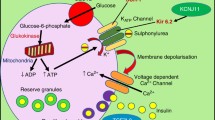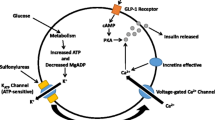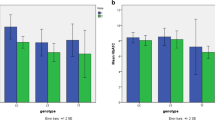Abstract
Aims/hypothesis
The aim of this study was to investigate whether genetic variance can influence the efficacy of glibenclamide in patients with type 2 diabetes.
Methods
A total of 747 patients with type 2 diabetes was enrolled from the Xiaoke Pills Clinical Trial, which is a double-blind, randomised controlled trial. All the patients had been treated with glibenclamide for 48 weeks, with strict drug dose adjustment and data collection. Treatment failure was confirmed when patients reached the criteria for terminating their participation in the study (fasting blood glucose level ≥7.0 mmol/l on two consecutive tests 4 weeks after reaching the pre-set maximal dose or maximal tolerated dose). Using this cohort, we tested 44 single-nucleotide polymorphisms (SNPs) in 27 gene regions. The genes in our study were involved in the metabolism of sulfonylureas, islet beta cell function, insulin resistance and beta cell growth and differentiation. A logistic regression model was used to evaluate the relationship between genetic variants and treatment failure over a period of 48 weeks.
Results
We found that no SNP reached the significance level of p < 0.00125 if Bonferroni correction was performed for multiple testing in the logistic regression model used in this pharmacogenetic study. Participants with the minor allele C of rs10811661 in CDKN2A/CDKN2B showed a significantly greater reduction in fasting blood glucose (TT vs TC vs CC: 9.3% (0–20.0%) vs 9.2% (0.9–20.5%) vs 12.7% (5.2–24.4%), p = 0.008) after the initial 4 weeks of treatment independent of age, sex and BMI. There was a significant difference in beta cell function among carriers of different genotypes of rs10811661.
Conclusions/interpretation
Our study demonstrated that the CDKN2A/CDKN2B gene may be nominally associated with the efficacy of glibenclamide, and that CDKN2A/CDKN2B is associated with beta cell function.
Similar content being viewed by others
Abbreviations
- FPG:
-
Fasting plasma glucose
- GWAS:
-
Genome-wide association study
- MAF:
-
Minor allele frequency
- SNP:
-
Single-nucleotide polymorphism
References
Kalow W, Tang BK, Endrenyi L (1998) Hypothesis: comparisons of inter- and intra-individual variations can substitute for twin studies in drug research. Pharmacogenetics 8:283–289
Groop LC (1992) Sulfonylureas in NIDDM. Diabetes Care 15:737–754
Suzuki K, Yanagawa T, Shibasaki T, Kaniwa N, Hasegawa R, Tohkin M (2006) Effect of CYP2C9 genetic polymorphisms on the efficacy and pharmacokinetics of glimepiride in subjects with type 2 diabetes. Diabetes Res Clin Pract 72:148–154
Lee CR, Goldstein JA, Pieper JA (2002) Cytochrome P450 2C9 polymorphisms: a comprehensive review of the in-vitro and human data. Pharmacogenetics 12:251–263
Kirchheiner J, Bauer S, Meineke I et al (2002) Impact of CYP2C9 and CYP2C19 polymorphisms on tolbutamide kinetics and the insulin and glucose response in healthy volunteers. Pharmacogenetics 12:101–109
Shon JH, Yoon YR, Kim KA et al (2002) Effects of CYP2C19 and CYP2C9 genetic polymorphisms on the disposition of and blood glucose lowering response to tolbutamide in humans. Pharmacogenetics 12:111–119
Takanashi K, Tainaka H, Kobayashi K, Yasumori T, Hosakawa M, Chiba K (2000) CYP2C9 Ile359 and Leu359 variants: enzyme kinetic study with seven substrates. Pharmacogenetics 10:95–104
Zhou SF, Zhou ZW, Huang M (2009) Polymorphisms of human cytochrome P450 2C9 and the functional relevance. Toxicology 278:165–188
Xie HG, Prasad HC, Kim RB, Stein CM (2002) CYP2C9 allelic variants: ethnic distribution and functional significance. Adv Drug Deliv Rev 54:1257–1270
Yang JQ, Morin S, Verstuyft C et al (2003) Frequency of cytochrome P450 2C9 allelic variants in the Chinese and French populations. Fundam Clin Pharmacol 17:373–376
Sesti G, Laratta E, Cardellini M et al (2006) The E23K variant of KCNJ11 encoding the pancreatic beta-cell adenosine 5’-triphosphate-sensitive potassium channel subunit Kir6.2 is associated with an increased risk of secondary failure to sulfonylurea in patients with type 2 diabetes. J Clin Endocrinol Metab 91:2334–2339
Javorsky M, Klimcakova L, Schroner Z et al (2012) KCNJ11 gene E23K variant and therapeutic response to sulfonylureas. Eur J Intern Med 23:245–249
Feng Y, Mao G, Ren X et al (2008) Ser1369Ala variant in sulfonylurea receptor gene ABCC8 is associated with antidiabetic efficacy of gliclazide in Chinese type 2 diabetic patients. Diabetes Care 31:1939–1944
Sesti G, Marini MA, Cardellini M et al (2004) The Arg972 variant in insulin receptor substrate-1 is associated with an increased risk of secondary failure to sulfonylurea in patients with type 2 diabetes. Diabetes Care 27:1394–1398
Pearson ER, Donnelly LA, Kimber C et al (2007) Variation in TCF7L2 influences therapeutic response to sulfonylureas: a GoDARTs study. Diabetes 56:2178–2182
Holstein A, Hahn M, Korner A, Stumvoll M, Kovacs P (2011) TCF7L2 and therapeutic response to sulfonylureas in patients with type 2 diabetes. BMC Med Genet 12:30
Schroner Z, Javorsky M, Tkacova R et al (2011) Effect of sulphonylurea treatment on glycaemic control is related to TCF7L2 genotype in patients with type 2 diabetes. Diabetes Obes Metab 13:89–91
Schroner Z, Dobrikova M, Klimcakova L et al (2011) Variation in KCNQ1 is associated with therapeutic response to sulphonylureas. Med Sci Monit 17:CR392–CR396
Sladek R, Rocheleau G, Rung J et al (2007) A genome-wide association study identifies novel risk loci for type 2 diabetes. Nature 445:881–885
Zeggini E, Scott LJ, Saxena R et al (2008) Meta-analysis of genome-wide association data and large-scale replication identifies additional susceptibility loci for type 2 diabetes. Nat Genet 40:638–645
Steinthorsdottir V, Thorleifsson G, Reynisdottir I et al (2007) A variant in CDKAL1 influences insulin response and risk of type 2 diabetes. Nat Genet 39:770–775
Grarup N, Andersen G, Krarup NT et al (2008) Association testing of novel type 2 diabetes risk alleles in the JAZF1, CDC123/CAMK1D, TSPAN8, THADA, ADAMTS9, and NOTCH2 loci with insulin release, insulin sensitivity, and obesity in a population-based sample of 4,516 glucose-tolerant middle-aged Danes. Diabetes 57:2534–2540
Wu Y, Li H, Loos RJ et al (2008) Common variants in CDKAL1, CDKN2A/B, IGF2BP2, SLC30A8, and HHEX/IDE genes are associated with type 2 diabetes and impaired fasting glucose in a Chinese Han population. Diabetes 57:2834–2842
Prokopenko I, Langenberg C, Florez JC et al (2009) Variants in MTNR1B influence fasting glucose levels. Nat Genet 41:77–81
Frayling TM (2007) Genome-wide association studies provide new insights into type 2 diabetes aetiology. Nat Rev Genet 8:657–662
Pearson ER, Liddell WG, Shepherd M, Corrall RJ, Hattersley AT (2000) Sensitivity to sulphonylureas in patients with hepatocyte nuclear factor-1alpha gene mutations: evidence for pharmacogenetics in diabetes. Diabet Med 17:543–545
Pearson ER, Starkey BJ, Powell RJ, Gribble FM, Clark PM, Hattersley AT (2003) Genetic cause of hyperglycaemia and response to treatment in diabetes. Lancet 362:1275–1281
Zhou K, Donnelly L, Burch L et al (2009) Loss-of-function CYP2C9 variants improve therapeutic response to sulfonylureas in type 2 diabetes: a Go-DARTS study. Clin Pharmacol Ther 87:52–56
Ji L, Tong X, Wang H et al (2013) Efficacy and safety of traditional Chinese medicine for diabetes: a double-blind, randomised, controlled trial. PLoS One 8:e56703
Takeuchi F, Katsuya T, Chakrewarthy S et al (2010) Common variants at the GCK, GCKR, G6PC2-ABCB11 and MTNR1B loci are associated with fasting glucose in two Asian populations. Diabetologia 53:299–308
Xueyao Han CL, Ji L (2005) Contribution of MODY6 gene in the pathogenesis of familial type 2 diabetes in Chinese population. Chin Med J 85:2463–2467
Winckler W, Weedon MN, Graham RR et al (2007) Evaluation of common variants in the six known maturity-onset diabetes of the young (MODY) genes for association with type 2 diabetes. Diabetes 56:685–693
Ruchat SM, Elks CE, Loos RJ et al (2009) Association between insulin secretion, insulin sensitivity and type 2 diabetes susceptibility variants identified in genome-wide association studies. Acta Diabetol 46:217–226
McCarthy MI, Zeggini E (2009) Genome-wide association studies in type 2 diabetes. Curr Diabetes Rep 9:164–171
Wen J, Ronn T, Olsson A et al (2010) Investigation of type 2 diabetes risk alleles support CDKN2A/B, CDKAL1, and TCF7L2 as susceptibility genes in a Han Chinese cohort. PLoS One 5:e9153
Rung J, Cauchi S, Albrechtsen A et al (2009) Genetic variant near IRS1 is associated with type 2 diabetes, insulin resistance and hyperinsulinemia. Nat Genet 41:1110–1115
Blaisdell J, Jorge-Nebert LF, Coulter S et al (2004) Discovery of new potentially defective alleles of human CYP2C9. Pharmacogenetics 14:527–537
Matthews DR, Hosker JP, Rudenski AS, Naylor BA, Treacher DF, Turner RC (1985) Homeostasis model assessment: insulin resistance and beta-cell function from fasting plasma glucose and insulin concentrations in man. Diabetologia 28:412–419
Gurwitz D, Pirmohamed M (2010) Pharmacogenomics: the importance of accurate phenotypes. Pharmacogenomics 11:469–470
Acknowledgements
We thank all the patients and all 15 hospitals for agreeing to join this study.
Funding
This study was supported by Funding National High Technology Research and Development Program (863 program, No. 2012AA02A509 and No. 2006AA02A409), Guangzhou Zhongyi Pharmaceutical, the National Natural Science Fund (No. 81000334) and the National Basic Research Program of China (973 program, No. 2006CB503903).
Duality of interest
The authors declare that there is no duality of interest associated with this manuscript.
Contribution statement
LJ, XH and QR were responsible for the conceptualisation and design of the study and were involved in data acquisition. QR, XH, YT, X. Zhang, XC, X. Zou, SZ, LZ and HL performed the analysis and interpretation of the data. QR, XH and LJ drafted the manuscript. XC, YT, X. Zhang, X. Zou, SZ, LZ and HL revised the manuscript for critical intellectual content. All authors approved the final version of the manuscript. QR and XH had full access to all the data in the study and take responsibility for the integrity of the data and the accuracy of the data analysis.
Author information
Authors and Affiliations
Corresponding author
Additional information
Qian Ren and Xueyao Han contributed equally to this manuscript.
Electronic supplementary material
Below is the link to the electronic supplementary material.
ESM Table 1
(PDF 24 kb)
ESM Table 2
(PDF 8 kb)
Rights and permissions
About this article
Cite this article
Ren, Q., Han, X., Tang, Y. et al. Search for genetic determinants of sulfonylurea efficacy in type 2 diabetic patients from China. Diabetologia 57, 746–753 (2014). https://doi.org/10.1007/s00125-013-3146-z
Received:
Accepted:
Published:
Issue Date:
DOI: https://doi.org/10.1007/s00125-013-3146-z




